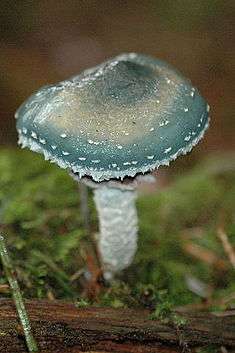Stropharia
| Stropharia | |
|---|---|
 | |
| Stropharia aeruginosa | |
| Scientific classification | |
| Kingdom: | Fungi |
| Division: | Basidiomycota |
| Class: | Agaricomycetes |
| Family: | Strophariaceae |
| Genus: | Stropharia (Fr.) Quél. (1872) |
| Type species | |
| Stropharia aeruginosa (Curtis) Quél. (1872) | |
| Synonyms[1] | |
| |
The genus Stropharia (sometimes known by the common name roundheads) is a group of medium to large agarics with a distinct membranous ring on the stipe. Well-known members of this genus include the edible Stropharia rugosoannulata and the blue-green verdigris agarics (Stropharia aeruginosa and allies). Stropharia are not generally regarded as good to eat and there are doubts over the edibility of several species. However the species Stropharia rugosoannulata is regarded as exquisitely edible when young, is now the premier mushroom for outdoor bed culture by mycophiles in temperate climates.[2]
Taxonomy
The scientific name is derived from the Greek 'στροφος/strophos' meaning "belt", in reference to it. Spore print color is generally medium to dark purple-brown with white edge at maturity, except for a few species that have rusty-brown spores. There is a great deal of variation, however, since this group as presently delimited is polyphyletic. Members of the core clade of Stropharia are characterized by crystalline acanthocytes among the hyphae of the mycelium and that make up the rhizoids at the base of the mushroom, and in one species, Stropharia acanthocystis, also occur in the hymenium.
Description
Recent molecular work shows the core group of the genus most closely related to Hypholoma and Pholiota. Other such as S. semiglobata are more distantly related. Stropharia had been divided into 'sections' by Rolf Singer among others, although some 'sections' were only informally named. Phylogenetically, separated genera now recognized by some authors for species lacking acanthocytes.[3][4][5][6] replacing these informal (invalid) sections are: Leratiomyces in 2008 in part replacing Section Stropholoma and Protostropharia in 2013 in part replacing section Stercophila.
The psychedelic mushroom formerly known as Stropharia cubensis was reclassified into the genus Psilocybe by mycologist Rolf Singer and subsequently this classification was supported by modern phylogenetic analyses based upon DNA sequence comparison.[3][5][6] It bears a superficial resemblance to Stropharia with its relatively large size, well-developed annulus, and dark spores, hence in some references it is referred to as Psilocybe cubensis,[7] however, it is simply a large-size example of the bluing Psilocybe and hence is not a close relative of Stropharia.
Species
- Stropharia acanthocystis
- Stropharia aeruginosa
- Stropharia agaricoides[8]
- Stropharia agrocyboides
- Stropharia albivelata
- Stropharia albonitens
- Stropharia albosulphurea
- Stropharia ambigua
- Stropharia araucariae[9]
- Stropharia aurantiaca
- Stropharia caerulea
- Stropharia chrysocystidia – China[10]
- Stropharia cifuentesii – Mexico[11]
- Stropharia coronilla
- Stropharia farlowiana
- Stropharia formosa[12]
- Stropharia halophila
- Stropharia hornemannii
- Stropharia inuncta
- Stropharia kauffmanii
- Stropharia lepiotiformis
- Stropharia luteonitens
- Stropharia mammillata
- Stropharia melanosperma
- Stropharia pseudocyanea
- Stropharia rubrobrunnea – Western Ghats, India[13]
- Stropharia rugosoannulata
- Stropharia squamulosa
- Stropharia variicolor[14]
- Stropharia venusta[8]
Gallery
References
- ↑ "Stropharia (Fr.) Quél. 1872". MycoBank. International Mycological Association. Retrieved 2011-09-11.
- ↑ Paul Stamets, Growing gourmet and medicinal mushrooms, pg. 334, Ten Speed Press, 3rd ed. (2000), ISBN 1-58008-175-4
- 1 2 Moncalvo JM, Vilgalys R, Redhead SA, Johnson JE, James TY, Catherine Aime M, Hofstetter V, Verduin SJ, Larsson E, Baroni TJ, Greg Thorn R, Jacobsson S, Clémençon H, Miller OK (2002). "One hundred and seventeen clades of euagarics" (PDF). Molecular Phylogenetics and Evolution. 23 (3): 357–400. doi:10.1016/S1055-7903(02)00027-1. PMID 12099793.
- ↑ Redhead SA. (2013). "Nomenclatural novelties" (PDF). Index Fungorum. 15: 1–2.
- 1 2 Walther G, Garnica S, Weiß M (2005). "The systematic relevance of conidiogenesis modes in the gilled Agaricales". Mycological Research. 109 (5): 525–44. doi:10.1017/S0953756205002868. PMID 16018308.
- 1 2 Matheny PB, Curtis JM, Hofstetter V, Aime MC, Moncalvo JM, Ge ZW, Slot JC, Ammirati JF, Baroni TJ, Bougher NL, Hughes KW, Lodge DJ, Kerrigan RW, Seidl MT, Aanen DK, DeNitis M, Daniele GM, Desjardin DE, Kropp BR, Norvell LL, Parker A, Vellinga EC, Vilgalys R, Hibbett DS (2006). "Major clades of Agaricales: a multilocus phylogenetic overview" (PDF). Mycologia. 98 (6): 982–95. doi:10.3852/mycologia.98.6.982. PMID 17486974.
- ↑ O. T. Oss, O. N. Oeric, Psilocybin: magic mushroom grower's guide: a handbook for psilocybin Enthusiasts, Quick American Archives, 2nded. (1993), ISBN 0-932551-06-8
- 1 2 da Silva PS, Cortez VG, da Silveira RMB (2009). "New species of Stropharia from Araucaria angustifolia forests of southern Brazil". Mycologia. 101 (4): 539–44. doi:10.3852/08-097.
- ↑ Cortez VG, Silveira RMB (2008). "The agaric genus Stropharia (Strophariaceae) in Rio Grande do Sul State, Brazil" (PDF). Fungal Diversity. 32: 31–57.
- ↑ Tolgor BAU, Meng TX (2008). "Strophariaceae of China (II). Stropharia". Journal of Fungal Research. 6 (1): 1–7.
- ↑ Bandala VM, Montoya L, Jarvio D (2005). "Agarics from coffee plantations in Eastern Mexico: two new records" (PDF). Fungal Diversity. 20: 17–29.
- ↑ Ratkowsky DA, Gates GM, Chang YS (2013). "Two new combinations in the Strophariaceae (Agaricales) of Tasmania" (PDF). Australasian Mycologist. 31: 39–40.
- ↑ Senthilarasu G, Singh SK (2013). "A new species of Stropharia from Western Ghats, India". Mycotaxon. 123: 213–220. doi:10.5248/123.213.
- ↑ Desjardin DE, Hemmes DE (2001). "Agaricales of the Hawaiian Islands, 7. Notes on Volvariella, Mycena, Physalacria, Porpoloma and Stropharia". Harvard Papers in Botany. 6: 85–103. JSTOR 41761629.
